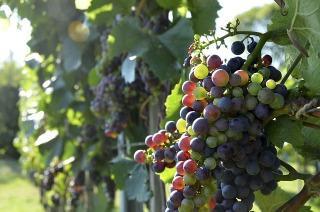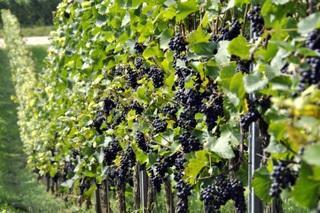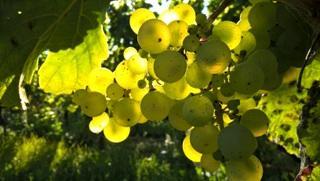
Vineyard Wines – from grapes with a history!
Red Muscadine
When Pedro Menéndez de Avilés founded what is now the oldest continuously occupied city in the United States, St. Augustine, Fla., in 1565, the goal was to establish a Spanish claim in this new land. They had hoped to find gold and other riches, and they most certainly would have noticed an abundance of muscadine grapes. And as early as the 1500s, muscadines were used for the commercial production of fine wines and port. In today’s vineyards, there are now a variety of muscadine grapes. Red Muscadine grapes can be pinkish, purple or even black in color. The addition of a sugar in the winemaking process frequently transforms the wine into a favored dessert wine. Others like a special dry red table wine made from bronze muscadine grapes.
Our Red Muscadine is Sam Duncan Reserve


Concord
The dark blue or purple of our favorite table grape – the very one we love in jelly, juice and even soft drinks – makes a sweet wine with a ripe flavor. Rich in color and aroma, the Concord Grape was developed in 1849 by Ephraim Bull of Concord, Mass. By 1853, Bull had introduced his homegrown grape to the public where in 1859 Thomas Bramwell Welch, upon finding a way to pasteurize this grape into a juice that would not ferment, created the Welch Grape Juice in 1869. It was Welch who introduced this sweet wine to his church as Communion Wine.
Our Concord is Saddle Up
White Muscadine
Of the four grapes that are cultivated in the United States, the Muscadine is one of the two that are native. With its natural home in the Southeastern region, it is a favorite even in California vineyards. Most indigenous Muscadine vines produce dark grapes – pink, purple or even black. However, the settlers and explorers of what is now North Carolina reported the abundance of the golden Muscadine grape. Sir Walter Raleigh’s dispatched explorers, Philip Amadas and Aurthur Barlow, described in 1584 what they felt was a surprising abundance of the grapes. In 1755, farmer Isaac Alexander found the first recorded source of White Muscadines along the Scuppernong Lake and began to cultivate the grapes. Today, the golden or green Muscadine (Scuppernong) is most similar to the green table grape but is much rounder and larger.
Our White Muscadine is Wales Station


Muscadine & Concord
Mixing grapes, unlike mixing other alcohol, can bring the best flavors of each type of grape. Drawing on the musky flavor of the Muscadine and the natural sweetness of the purple Concord, the blend of grapes highlights the best of both.
Our Muscadine and Concord blend is Miner’s Twist
Niagara
The Niagara Grape is green in color and is known as the most common grape used for white grape juice. It is grown, in the United States, most commonly in Niagara County, New York. The grape was the result of a cross-breeding of the white Cassaday Grape and the rich red/purple Concord. Claudius Hoag and Benjamin Clark were the first to grow the Niagara Grape. By 1882 it was being sold commercially in the areas close to where it is grown. A fragile grape, it is known for its sweet aroma and flavors that taste a little of lemon and flowery jasmine.
Our Niagara is Campbellsville Bears


Catawba
The purplish-red grape of the Catawba is a favorite for wines, juice, jams and jellies. Its origins are lost to history, but there is a lovely story that it came from the Rose Hill property of Rockville, Maryland. In the early 1800s this land was given to Lewis and Eliza Wootton Bell as a part of Eliza’s dowry. The grapes may have come from cuttings of vines discovered in 1801 in North Carolina, traveling north to Montgomery County, Maryland, in 1816 in the care of a traveler, John Scholl, who left the cuttings with an innkeeper in Clarksburg.They appeared at Rose Hill shortly thereafter when Eliza Beall obtained some cuttings from her brother Singleton Wootton, who had, in turn, gotten them from Scholl.
Regardless of its origins, it is a hallmark grape in winemaking history in the United States as it was the most popular grape in the country, used for sparkling wines distributed as far afield as Europe and California by the mid-1800s. However, between a blight and the chaos of the Civil War, the Catawba faded from popularity. It is now a specialty wine known for its shades of pink and white and for its musky and earthy flavor.
Our Catawba is Richland Creek Haze
Norton Grape
The Norton Grape, a deep blue/purple grape named for its developer, Dr. Daniel Norton of Richmond, Virginia, came from cuttings he thought to be an extinct grape called Bland. Whether he actually discovered an extinct grape or not, Dr. Norton most assuredly found some wild vine that he cultivated as his namesake. By 1830 the grape was being grown commercially and became the cornerstone of Missouri’s wine industry soon after, dominating the Midwestern and Eastern United States. The grape produced award-winning wine, taking a Gold Medal in the Vienna World Exposition of 1873. Norton Grapes remained America’s grape wine until Prohibition stopped the wine industry. During that era, many of the Midwestern fields that had grown Norton Grapes were pulled out to be replaced by Concord Grapes used in jellies, jams and juices. By the end of Prohibition, the once vital industry of Norton Grape growers was gone. The industry moved west to California. Today, we know from genetic testing of the Norton Grape that it actually shares the same coloring as blueberries, cherries, raspberries and blackcurrants. And the Norton Grape is making a comeback in the Eastern and Midwestern parts of the United States. It was even honored with a special stemware designed in 2009 by Riedel exclusively for Norton Grape Wines.
Our Norton Grape is Kudzu Overload


Chambourcin
Chambourcin is a species of grapevines belonging to the Vitis genus in the flowering plant family Vitaceae. It is a French-American interspecific hybrid grape variety used for making wine. Its parentage is uncertain. The hybrid was produced by Joannes Seyve who often used Seibel hybrids produced in the 1860s. The grape has only been available since 1963; it has a good resistance to fungal disease, and is one of the parents of the new disease resistant variety, Regent, which is increasing in popularity among German grape growers. The grape produces a deep-colored and aromatic wine. It can be made into a dry style or one with a moderate residual sugar level. Chambourcin is a teinturier, a grape whose juice is pink or red rather than clear like most red vitis vinifera cultivars.
Our Chambourcina are Firehawk and Red Hawk.
Orchard Wines – from the bounty of a country harvest
Most any fruit can become a delicious Orchard Wine, also knows as “Country Wine.” A harvest of peaches, blueberries, blackberries, apples, cherries, strawberries and pears are the natural bounty of the Big Creek Winery orchard. And these homegrown ingredients make wines meant to be enjoyed as soon as the bottle is corked. The grape is the fruit with the natural balance of yeast and sweetness for fermentation. Orchard Wines requires the skill of the winemaker to find that special place where taste (sweet or tart) and fermentation come together in just the right blend to leave you with a glass of cool, refreshing natural country in your wineglass.




